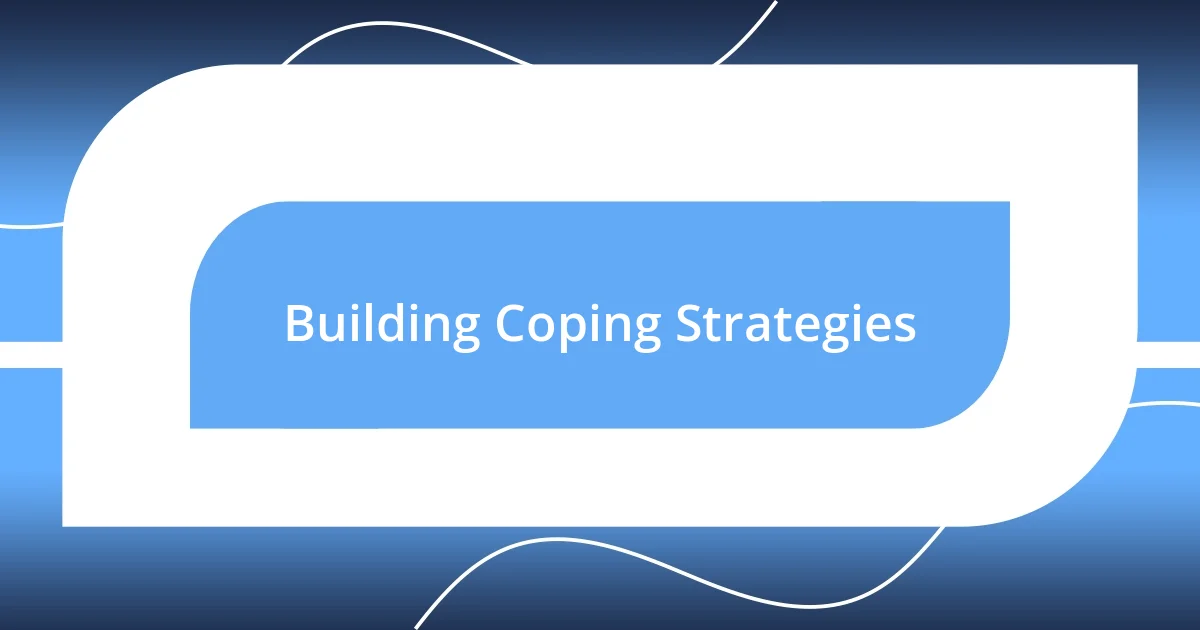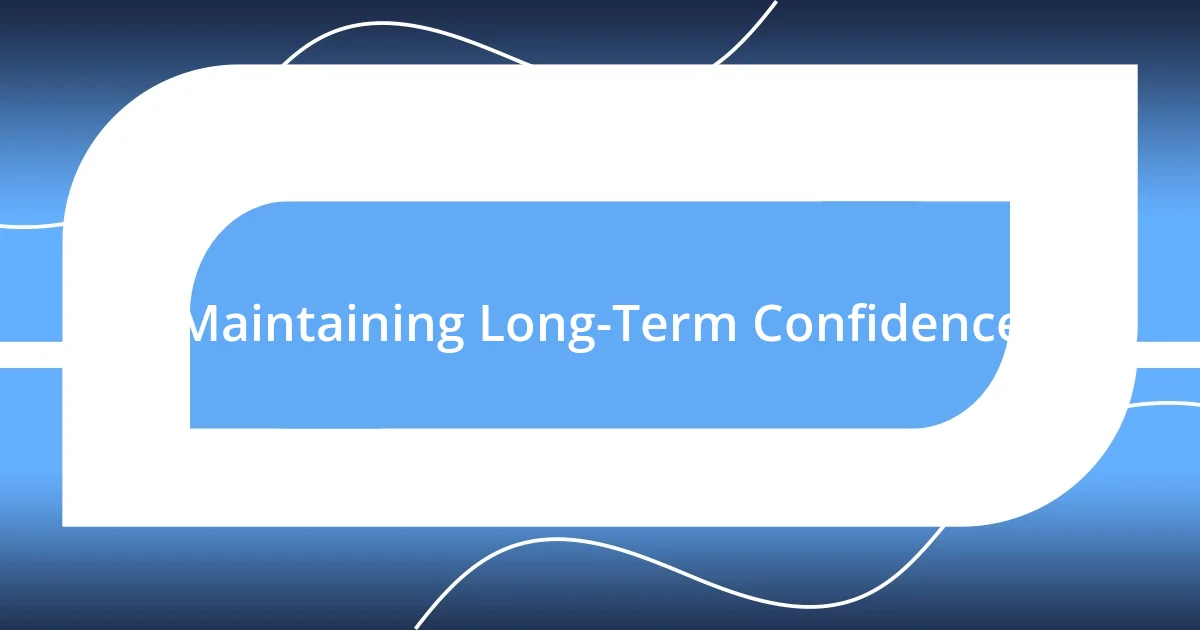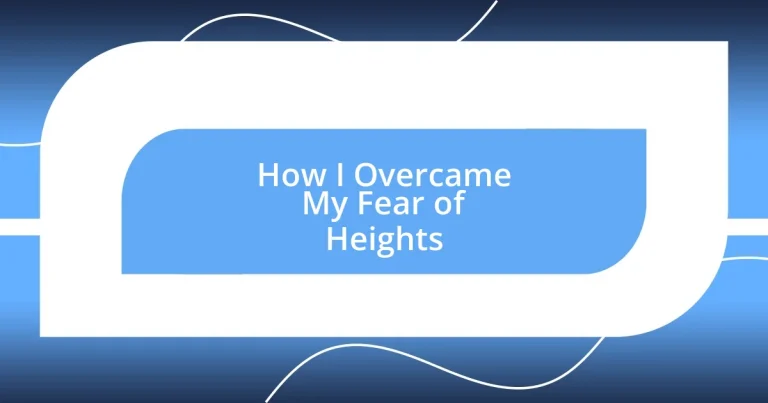Key takeaways:
- Recognizing personal triggers and understanding their origins is crucial in confronting acrophobia.
- Gradual exposure techniques and the support of friends provide a structured approach to overcoming the fear of heights.
- Celebrating small victories and maintaining a strong support network reinforce confidence and encourage continued progress.

Understanding the Fear of Heights
Fear of heights, or acrophobia, is more common than we think. I remember the first time I felt that stomach-dropping sensation while standing atop a tall building; the ground felt miles away, and my heart raced as my mind spiraled into doubt. Have you ever wondered why something as benign as a high vantage point can trigger such intense fear in us?
It’s fascinating how our experiences shape these fears. For me, a childhood incident involving a rickety ladder left a lasting impression. The emotional echo of that moment made me question my sense of safety, especially in elevated spaces. Isn’t it intriguing how a single event can set the stage for deeper anxieties?
Societal influences and personal experiences play a huge role in acrophobia. I’ve often found myself caught in a mental tug-of-war: part of me craved the view from the top, while another part screamed to stay grounded. What causes this inner conflict? It’s a reminder that understanding fear is more than just facing a phobia; it’s about unraveling what lies beneath.

Recognizing Personal Triggers
Recognizing personal triggers is a critical step in overcoming a fear of heights. I realized my triggers were often linked to specific situations or memories. For instance, a visit to an observation deck where I felt the floor sway beneath me instantly catapulted me back to that childhood experience with the ladder. It was in those moments that I learned to identify the sensations—sweaty palms, quickened heartbeat—that warned me my fear was about to resurface.
To better understand my triggers, I began to list them, allowing me to gain insight into what specifically increased my anxiety. Here are some of the triggers I recognized:
- Nostalgic reminders of past falls or heights, like a childhood playground with tall slides.
- Crowded spaces where I felt trapped, such as a packed elevator heading to the top floors.
- Situations where I lacked control, like being on a shaky platform or a high balcony during strong winds.
- Watching a scary video or movie that involved heights, which amplified my anxiety in real life.
Reflecting on these triggers not only empowered me to face them but also helped me devise strategies to manage my fear when it struck.

Preparing for Exposure Therapy
Preparing for exposure therapy was an important step in my journey to conquer my fear of heights. I vividly remember the knot in my stomach as I began preparing for what felt like a daunting challenge. Gathering the right tools to face my fear head-on was crucial. I focused on creating a detailed plan that included visualizing heights, slow exposure to various scenarios, and practicing relaxation techniques like deep breathing. Has anyone else felt overwhelmed at the thought of facing a fear? It truly helped me to break it down into manageable pieces.
Another key part of my preparation was seeking support. I reached out to friends who understood my struggle, and I learned that sharing my fears eased some pressure. Discussing my anxiety with them provided a sense of accountability and encouragement. I remember one evening I stood atop a tall staircase, clutching the railing while my friend encouraged me to look out and appreciate the view. It was a simple yet profoundly supportive experience, emphasizing the significance of having a buddy during this process.
Lastly, I took the time to educate myself about acrophobia and exposure therapy techniques. Knowledge was empowering! I read books and articles on managing anxiety, quickly realizing that understanding the psychological aspects of my fear would help me face it. This preparation gave me a sense of strength and control. I still recall feeling that surge of empowerment when I recognized that I wasn’t alone on this journey.
| Preparation Steps | Description |
|---|---|
| Visualization | Imagining myself in high places to desensitize my mind. |
| Support System | Engaging with friends who encouraged and motivated me during exposure. |
| Education | Reading about acrophobia and exposure techniques to boost my confidence. |

Gradual Exposure Techniques
Gradual exposure techniques became my roadmap as I tackled my fear of heights. At first, I focused on smaller challenges, like standing on my tiptoes to peek out a window on the second floor of my house. I recall that thrilling mixture of anxiety and exhilaration; it felt like climbing a mountain, but in those moments, I learned that each tiny victory mattered.
One experience that stands out was visiting a local park with a tall observation tower. I didn’t rush to the top; instead, I sat at the base for a while, my heart racing as I observed others ascending. Allowing myself time to acclimate was crucial. I kept asking myself: Why did I feel anxious just by watching? That curiosity to understand my feelings allowed me to take a smoother step forward—eventually, I climbed just a few levels, using the railing as my anchor.
As I moved forward, I found that integrating mindfulness while facing heights enhanced my exposure experience. When I gazed down from a slight elevation, rather than spiraling into panic, I focused on my breath. It was fascinating how grounding my breath transformed my perception. I often thought, could simply breathing really counterbalance fear? The answer was yes. Each time I practice this, I felt a little more like an adventurer in my own story, slowly turning a daunting cliff into manageable stepping stones.

Building Coping Strategies
Building coping strategies was an essential phase of my journey toward overcoming my fear of heights. I quickly discovered that grounding techniques worked wonders during my moments of anxiety. I remember one particularly eye-opening instance when I was about to climb a flight of stairs leading to a high patio. I took a deep breath and focused on the sensation of my feet hitting each step. Why did that simple act bring me so much comfort? It was a reminder that while the situation felt overwhelming, I had the ability to control my actions and my mind.
Creating a mantra became vital in this process. Whenever I felt the familiar pangs of anxiety creeping in, I’d quietly repeat phrases like “I am safe” or “This is just a height.” I found that these affirmations anchored me in the present. One day, as I stood on a second-floor balcony, the urge to retreat washed over me, but I chanted my mantra, and to my surprise, the anxiety dipped. Could the power of positive self-talk truly reshape my experience? Absolutely. The more I applied this technique, the stronger I felt in the face of my fear.
Additionally, I began documenting my experiences in a journal. Writing about each encounter with heights was cathartic. I recalled the excitement of finally climbing that observation tower and felt a sense of accomplishment. I would sometimes ask myself, “What did I learn from this experience?” Each entry reinforced my progress and reminded me that growth is not always linear. This practice became a crucial part of my coping strategy, allowing me to reflect on both my victories and the lessons learned through challenges.

Celebrating Small Victories
Reflecting on my journey, I can’t help but cherish those small victories that felt monumental at the time. One day, I stood on a low step stool to reach a high cabinet. My heart raced as I climbed those few feet, but when I reached my goal, the feeling was electric. I realized celebrating these moments built my confidence bit by bit. Isn’t it amazing how little wins can shift our perspective?
Another small win came when I attended a friend’s outdoor party on a second-floor balcony. Instead of hiding in the corner, I chose to step closer to the railing. The air felt different up there—tinged with excitement and a hint of fear. I remember turning to my friends and laughing at the view, a mix of exhilaration and disbelief swirling inside me. Did I think I could feel this way? Absolutely not. But that shift, that joy, it fueled my desire to push further.
I also learned that sharing these victories with loved ones magnified their significance. I vividly recall telling my sister about my experience on the step stool. Her enthusiastic response reminded me that every progression mattered. When you embrace these small milestones, you create a tapestry of achievements that bolster your courage. Have you ever felt that buzz from sharing a success? It’s contagious, and it solidifies your journey forward.

Maintaining Long-Term Confidence
Maintaining confidence over the long haul can sometimes feel like walking a tightrope—challenging, but rewarding when you find your balance. I vividly remember a weekend getaway when a hike led me to a breathtaking overlook. Standing there, heart pounding but exhilarated, I realized that confidence is an ongoing practice, not a one-time achievement. The sheer beauty of that moment made me ponder, “Why not embrace this feeling more often?”
One key to sustaining that confidence lies in regular exposure to the heights that once terrified me. I found myself seeking out situations where I could face my fears—a climbing wall at a local gym became a regular haunt for me. With each ascent, I experienced a blend of anxiety and triumph. I often asked myself, “What’s the worst that could happen?” and, surprisingly, the answer was often nothing at all. By continually challenging myself, I discovered that my capacity for courage was far greater than I initially believed.
Moreover, building a support network played a pivotal role in my journey. I connected with fellow adventurers who understood and cheered on my progress. During a particularly challenging moment at a scenic lookout, my friend urged me to take a step further and enjoy the view. Sharing that experience with someone who believed in my growth made a world of difference. Isn’t it fascinating how connection can amplify our successes, making us braver than we might dare to be alone?














